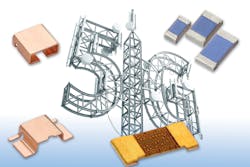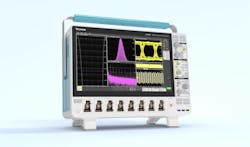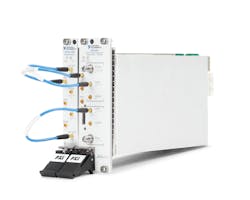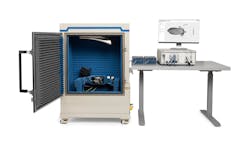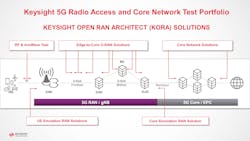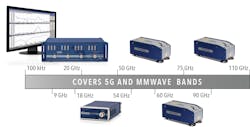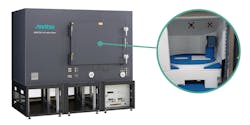2021 Special Report: 5G Test
This article appeared in Evaluation Engineering and has been published here with permission.
There are many aspects of 5G systems that need monitoring, evaluation, and management beyond the RF spectrum issues.
This important wireless space is on everyone’s mind, as the infrastructures and devices to serve the 5G application space are being created and fielded. The 5G infrastructure is growing in leaps and bounds, with more and more capability being added to the system. However, the effectiveness of the solution is strongly based on how well the solution is evaluated, calibrated, and validated. Here is an update on some of the advances in the 5G test, evaluation, and infrastructure space.
Don’t Forget the Passives
One of the aspects of the electronics marketplace is the tendency to focus on the “stars” of the circuit board, the microcontrollers, FPGAs, ASICs, and SoCs; there are a lot of passive components on the board as well. These passives are just as responsible for the success or failure of any design as much as the more glamorous parts on the board. VPG Foil Resistors, part of the Vishay Precision Group, currently offers three power brands: Vishay Foil Resistors, Powertron, and Alpha Electronics.
The demand for precision and accuracy in 5G systems extends to every component, and the performance of the company’s Bulk Metal Foil resistor technology is well-suited for use in 5G test and evaluation equipment (Fig. 1). For example, the FRFS 0402 flip-chip resistor is a discrete, surface-mount device with a 40% smaller footprint compared to wraparound units, with a TCR of ±2.5 ppm/°C, and a load life stability of 0.01% after 2,000 hours. Like the rest of their Bulk Metal Foil resistor line, it is impervious to electrostatic discharge up to 25,000 V, is low noise, and is virtually noninductive and noncapacitive.
Alpha Electronics’ RWs series of SMT chip resistors in 0603, 0805, and 1206 sizes offer a TCR of 2 ppm/°C and load life of 0.005% after 2,000 hours. Their CSMxY series, a cost-effective bare-metal current-sense resistor currently is available in 2726 and 4026 variations and boasts a TCR of 40 ppm/°C with a current rating of 100 A, well-suited for testing the performance of the power system within any network array.
The challenge for VPG Foil Resistors components is that the parts are not made to be exposed to the data signal. While being unsuited to be incorporated into 5G signals themselves, their parts are well suited for the peripheral systems, providing stable performance no matter the temperature or life span of the product. 5G equipment consists not only of the antennas which relay the signal, but also measurement and calibration equipment, as well as the power management to create the signal, and the system management to control that power.
By ensuring the transition into the field is accurate and robust, the equipment manufacturers can be assured their systems remain calibrated, accurate, and will withstand the test of time. The initial cost of these new test systems requires any manufacturer to demonstrate their ability to be reliable such that their customer’s ROI is maximized. VPG Foil Resistors components allow those subsystems to be calibrated less often, maintain their calibration throughout the various intended use environments (think Alaska in January and Phoenix in July), and to provide a lower cost of ownership to the ultimate end customer.
Covering the Spread
When we asked Joe Dussi, Director of Marketing Communications at Qorvo, about some of the challenges the company is seeing, he explained that one of the challenges facing the industry is maintaining adequate oversampling on waveforms to address wider and wider New Radio (NR) signals. It’s important to field hardware implementations that capture the desired data, rejecting unwanted errors.
In addition, the customizability of 5G NR frame structure requires considerable nonstandard waveform generation. 5G NR supports two frequency ranges, using flexible subcarrier spacing derived from the one used in LTE. RF system designers require more power and bandwidth, while optimizing solution size and efficiency, especially when high reliability and performance are critical.
For example, the company’s RF Fusion20 portfolio serves major 5G smartphone manufacturers, combining their gallium-arsenide (GaAs) power amplifiers, advanced bulk-acoustic-wave (BAW) multiplexing, and integrated RF shielding, offering enhanced performance and connectivity. Supporting all major baseband chipsets, Fusion20 modules integrate the receive path and low-noise amplifier, increasing receive performance and connectivity while saving valuable board space.
Fusion20 also features Qorvo’s innovative MicroShield RF shielding, which minimizes the potential for undesirable interactions between RFFE components. Fusion20 helps support the most stringent 5G bandwidth requirements of up to 200 MHz, leveraging the QM77048 mid-/high-band, QM77043 low-band, and QM78207/208/209 ultra-high-band modules, in regional configurations to meet specific market requirements. Qorvo has optimized Fusion20 as a full 5G front-end solution complemented by Qorvo’s Wi-Fi 6/6E modules.
Beaming about Beamforming
Raajit Lall, Tektronix General Manager of Market Solutions and Software, brought up the two primary challenges they see that instrument vendors and customers face: the bandwidth requirements of 5G and the ability to test multidomain signals. For example, The MSO6B oscilloscope has a digital downconverter (DDC) built into the ASIC, which allows for simultaneous correlation of time domain and frequency domain tests (Fig. 2).
These tests are becoming critical because beamforming architectures require tight correlation between the digital signals and the phase array antennas in devices. The MSO6B also has up to 10GHz of time domain bandwidth and 2 GHz of DDC bandwidth, which allows test engineers to more future-proof their investments, and keep up with the increasing bandwidth requirements of 5G and 6G.
Tektronix has a wide portfolio of products addressing 5G testing, ranging from USB spectrum analyzers for narrowband measurements that apply to massive machine-type communications (mMTC) to AWGs and mixed-signal oscilloscopes that have the wide bandwidth needed for enhanced mobile broadband (eMBB). The MSO6B oscilloscope is an excellent instrument for wide bandwidth analysis of 5G signals and the AWG70000B arbitrary waveform generator delivers 5G signals with 10 GHz of receive and 20 GHz of transmit bandwidth each.
In addition, SignalVu-PC is an intuitive software that provides an intuitive UI for 3GPP-compliant measurements and a programmable interface for automation of measurements. The newly released Tektronix 8 series sampling oscilloscope provides up to 30 GHz of bandwidth for backhaul and data-center test applications including TDECQ, 400G, and PAM4. The 8 series sampling scope provides parallel measurements on up to four channels and provides a modular design all in a small form factor.
MIMO and OTA
Two trends accelerated because of 5G and anticipated continuation into 6G technologies are MIMO testing and over-the-air (OTA) testing. MIMO especially proves to be an interesting challenge for test engineers, since not only do they have to test for multiple channels that are phase-aligned, but they also have to test large sets of channels at wide bandwidths. OTA provides a whole new set of challenges, since test engineers have to integrate chambers and positioners into their labs. Calibration of thermal chambers, with all the permutations of positions that the device needs to be tested, can be time consuming and error prone.
Tektronix instrumentation provides a variety of solutions for physical-layer testing of mMTC and eMBB. By using a single software package (SignalVu-PC) for high channel narrow band tests that can be done with USB spectrum analyzers; or wide bandwidth, high-performance spectrum analyzers and oscilloscopes test engineers can use a familiar interface for all of their physical-layer test requirements. Tektronix also has robust solutions for backhaul testing. Compliance and validation packages for 400G and PAM4 test wireless and wired communications.
New Radio and mmWave
On industry 5G challenges, Andreas Roessler, Technology Manager at Rohde & Schwarz USA, pointed out that 5G New Radio (NR) is the first standard to use the mmWave frequency region FR2 (i.e. beyond 24 GHz) for highest data transfer rates. The highly integrated front-ends and array antennas necessitate advanced OTA testing methods and new RF test metrics for assessing current and future mobile communication. Such test metrics include virtual cable calibration (VCC), which is mandatory for reproducible and reliable OTA throughput testing. For performance tests in which fading is emulated, the VCC method is crucial to assess defined antenna correlations with minimal crosstalk from the OTA link.
One of the biggest challenges for test and measurement manufacturers is implementing standardized evaluation and verification methods for UE under repeatable and realistic conditions, which are also reliable with mass production processes. For LTE and 5G NR FR1 tests, conductive testing methods are the norm for MIMO devices. During testing, the antennas of the device under test (DUT) are disconnected from the antenna ports, and the DUT is directly connected to the test system using a coaxial cable. However, for testing UEs in the FR2 bands, this approach is not practical: the large number of integrated antennas on the UE for spatial multiplexing and beamforming requires testing OTA, without cable connections.
The transmitted signal propagating in the OTA radio channel gets distorted by inherent interference due to cross-talk and by the receiver’s noise. To have defined and reproducible conditions similar to conductive testing, the effects of the OTA channel must be eliminated. One approach to solve this issue is to calculate the unknown OTA transfer matrix by accounting for the complete OTA environment, including the transmitter and receiver antenna characteristics. This approach is complex and, in most cases, not possible as UE manufacturers are not required to give detailed information about their antenna characteristics (known as the "black box" assessment approach).
A suitable approach, developed by Rohde & Schwarz, equalizes the OTA channel matrix using only the Reference Signal Received Power per Branch (RSRP-B) feedback parameters, which can be retrieved from an NR UE according to the 3GPP standards. This OTA channel equalization enables having a quasi-conducted or “virtual cable” in an OTA test environment.
The approach lays the foundation for practical 5G UE performance testing, e.g. for maximum throughput. An equalized OTA channel is mandatory for all conformance tests under fading conditions, and it is recommended for all tests which rely on “ideal” radio conditions, such as protocol or application tests. Rohde & Schwarz introduced a high-speed virtual calibration tackling the challenge of noise- and resolution-limited RSRP-B feedback, which provides perfect prerequisites for the challenges of OTA testing.
Space Saving
In 5G NR FR2, all measurements are to be performed OTA. To reduce the required chamber space, CATR is a hot technology that Rohde & Schwarz has been addressing with compact and portable chambers such as the R&S ATS1800C. Now the next challenge comes along: RRM (radio resource management) testing in FR2. For this, the UE needs to be confronted with two independent base-station signals coming from different angular directions.
To accomplish this in a compact OTA setup, Rohde & Schwarz developed an extension of the R&S ATS1800C to create a multireflector setup that addresses this issue. With the R&S ATS1800M, a total of four reflectors can create six different pairs of incident angles at the DUT. This fulfills the requirements of the 3GPP RRM spec, but allows for even more flexible measurement setups where needed. Since each reflector can create an independent 30-cm quiet zone (QZ), these RRM tests can still be done using a black box approach, keeping the resulting measurement uncertainty low.
Besides RRM with one or two angles of arrival, the R&S ATS1800M can be used for RF conformance, protocol conformance and demodulation tests, making it a “one chamber for all requirements” solution that still only takes up about 5 sqm of lab space. The multireflector extension is designed in such a way that it can be added to an existing R&S ATS1800C as an upgrade at any time. The R&S ATS1800M will be available by summer 2021.
Voice-over-NR
Mobile voice services continue to play an important role, also in 5G. More and more network operators are starting to deploy 5G standalone (SA) networks. This opens the door for high-quality 5G Voice over New Radio (VoNR) voice and data calls for the traditional operators, but also for a variety of new verticals. Voice over NR represents the voice services provided by the 5G RAN, 5GC, and IMS. Voice over 5G works in a similar way as Voice over LTE, using IMS as service enabler.
The advantage is that IMS manages (like in VoLTE) the PDU session establishment with the relevant QoS flow for optimized voice quality. The prerequisites for VoNR are support for IMS voice over PS by the UE. In terms of testing voice services in 5G, first implementations and functional behavior is being tested. While the general test setup for VoNR is not that different from the one used for VoLTE, different test areas should be considered.
The testing aspects of voice over 5G include scenarios for VoLTE for non-standalone (NSA) mode as well as EPS fallback, providing a handover during connection setup from NR to LTE, or a RAT fallback if the LTE NG-eNB is connected to the 5GC. And last, but not least, VoNR functional tests and audio-quality tests have to be performed. From the perspective of speech codecs, a test system for voice over 5G has to support the legacy speech codes AMR-NB and AMR-WB in addition to the EVS codec.
A test setup for voice and video applications in 5G is depicted in Figure 3, showing the mobile radio tester R&S CMX500 together with the R&S CMW500 supporting LTE and 5G NR for either standalone or non-standalone connectivity testing. The R&S CMX500 supports an internal IMS server, enabling virtual UE emulation and audio loop-back mode for fast and easy functional VoNR testing. The setup can be extended as shown by an audio analyzer connected either via “IP forward” or routing of the audio via “DAU USB” to an external media endpoint, the R&S CMX-ZG180A.
To permit audio tests according to IEC 62820-1 or ITU-T P.51 standards, the setup shown can either be used with an artificial head with artificial ear and mouth. For so-called electrical measurements, the DUT might be connected via the speaker output directly to the audio analyzer input, and the microphone output directly to the audio analyzer output. The R&S CMW500 platform, which has been very successful in the market for voice-quality analysis for 2G, 3G and 4G, is now being expanded for 5G VoNR applications with the R&S CMX500.
3GPP's Release 16 emphasizes—besides other things—the two market verticals, industrial Internet of Things (IIoT), and automotive. They challenge the industry with new sets of requirements such as increased reliability, security, and very low latency, typically summarized as ultra-reliable low-latency communication or URLLC. The second trend is that the hunt for higher data rates will continue. For upcoming Release 17, 3GPP discusses the support of 1024QAM in the downlink direction for the Frequency Range 1 (FR1).
For the extension of Frequency Range 2, often called FR2+, wider bandwidths are under discussion, for instance, up 2 GHz, 2.16 GHz, or even 3.2 GHz. Whatever the standardization body decides on will pose new challenges in designing devices and infrastructure components that support these additional capabilities. Fortunately, the R&S FSW signal and spectrum analyzer supports already today a signal analysis bandwidth of up to 8.3 GHz, which is unparalleled in the test and measurement world.
Rohde & Schwarz considers OpenRAN a technology evolution that incorporates new functions into the RAN, to disaggregate and modularize the architecture and to enable software-defined radio, real-time intelligent control, network management and orchestration, and networking techniques. In a very simplified way, T&M does not distinguish between traditional RAN and OpenRAN. Though most of the test requirements are similar, the company’s portfolio includes test solutions for emulating the O-DU and test and verification of the O-RU.
Addressing Complexity
The kind people at NI told us that some of the key challenges they see are related to working with more complex, high-bandwidth signals, as their customers routinely develop devices that support at least 100-MHz-wide carriers, moving on to 200-MHz, 400-MHz, carrier-aggregated test scenarios with 8 x 100-MHz signals, and inter-band combinations. To increase the energy efficiency of their RF front ends, for example, they look for techniques such as digital predistortion (DPD) and envelope tracking (ET) to help them achieve their target performance.
But applying DPD linearization on large bandwidth signals is computationally intensive and requires even higher bandwidth instrumentation. Similarly, implementing ET on 100-MHz, 200-MHz, and wider signals is very challenging, if not impossible with current technology.
By taking advantage of the PXI platform, NI can give customers greater data-processing capabilities, and they collaborate with industry leaders like Maxlinear on cutting-edge digital predistortion.
NI is currently addressing three areas of research and development, among others: more capable instrumentation (hardware), more efficient measurement algorithms and software tools, and mission-ready system-level integration. In terms of instrumentation, NI continues to invest in wideband, high-linearity RF measurements for 5G Frequency Range 1 (FR1, sub 6 GHz) and Frequency Range 2 (FR2, or mmWave) through the vector signal transceiver (VST), an instrument that integrates both vector signal generation and analysis in one. The VST enables validation and test of the latest 5G cellular and early Wi-Fi 7 connectivity front ends, transceivers, and user equipment (Fig. 4).
Regarding measurement algorithms and software tools, NI continues to expand the waveform generation and analysis capabilities of its RF measurement experience (RFmx) API, keeping up with the latest advances in the 3GPP 5G standard. RFmx gives validation and test engineers flexibility to create and apply very large combinations of 5G stimulus waveforms to their DUTs by varying multiple parameters, such as waveform bandwidth, subcarrier spacing, modulation scheme, and carrier-aggregation combinations. On the analysis side, RFmx implements multi-threaded, parallel-processing technology for accurate measurement results rapidly, compared to more traditional sequential-measurement approaches.
NI has a series of reference architectures and highly integrated automated test systems to validate and test 5G semiconductor and electronic devices. The RF Front-end Validation reference architecture gives validation engineers focused on wideband RF front ends a tightly synchronized PXI bench with multiple instruments, from dc, to digital, to RF, plus software for cockpit-like control of their benches, access to the latest DPD linearization algorithms, and a fast path to automated characterization.
As engineers develop multi-element antenna modules for FR2 mmWave connections, they face the tough challenge of validating and testing their beamsteering performance. Engineers must make their measurements OTA in a controlled RF environment inside anechoic chambers (Fig. 5). These chambers also must support rotation of the DUT in azimuth and elevation to determine the DUT’s 3D spatial radiation pattern, the effective isotropic radiated power (EIRP), total radiated power (TRP), location of beam peaks and nulls, and other measurements.
These OTA measurements also help characterize the DUT’s capabilities for beamforming and calibrate the beam direction based on specific DUT control words. To help engineers accelerate development in this area, NI introduced the 5G mmWave OTA validation reference architecture, which takes advantage of NI motion control to speed up 3D spatial measurements 5X to 10X, compared to more traditional methods.
At the semiconductor level, one of the biggest trends is in OTA validation and testing. First, devices keep pushing higher in frequency toward the upper range of FR2 around 48 to 52 GHz. Second, there’s a growing need for very reliable and fast mmWave OTA production test solutions that support parametric testing of antenna modules. To meet the current trends in demand for mmWave capabilities in user equipment and customer premise equipment, these test systems must test thousands of units per hour.
mmWave capabilities will continue to propagate down from flagship devices to more mid-range user equipment. In user equipment, the mmWave configuration relies on multiple sub-arrays to make 3D beamforming possible and to avoid problems with a user’s hands covering the mmWave beam. Typical configurations could include three or four antenna arrays on a smartphone, with each array consisting of four antenna elements. This will result in increased demand for faster and more cost-effective mmWave OTA test and evaluation solutions, capable of parametric measurements to indicate potential beamforming problems in the field.
Accuracy and Efficiency
When it came to the question of industry challenges, Dr. Houman Zarrinkoub, Principal Product Manager, Wireless Communications at MathWorks, said that the main challenges they see involve accuracy and efficiency. When it comes to accuracy, designers need to find accurate and reliable signal vectors and cover all of the test cases needed to qualify a system to be compliant with the 5G standard. MathWork’s 5G Toolbox enables reliable access to these test vectors, rigorously verified by their engineers.
As far as efficiency goes, it takes a considerable amount of time to test the physical-layer (PHY) subsystems of 5G devices, with all their modes, frequencies, and parameters. Any environment and tool that can perform test vector generation, scripting, and executing (i.e., over-the-air transmission more efficient) can make test engineers substantially more efficient.
The company’s Wireless Waveform Generator app is designed to make all of these three steps more efficient. By generating waveforms interactively, then generating MATLAB scripts that capture the waveform generation process as a test script and then connecting the waveforms directly to the RF instrument, the app goes a long way to address these challenges.
MathWork’s 5G flagship product, 5G Toolbox, includes test models (NR-TM) and fixed-reference channel (FRC) signals defined directly as part of 5G standards documentation. This helps designers verify and validate their 5G designs accurately. Waveform generation is an important requirement for testing any design.
The recently introduced Wireless Waveform Generator app makes the testing process easier and more interactive. As an interactive and graphical tool for testing, the app generates, visualizes, and integrates 5G test signals within its test environment. As a result, any user, even those who are not MATLAB programmers, can easily generate 5G test vectors.
The app supports a wide range of wireless standard waveforms such as 5G, Wi-Fi, and Bluetooth. The app also supports off-the-shelf testing signals specified by standard documents including test models as well as the fixed reference channels. As of release 2021a, custom 5G waveform generation also is included in the app, which enables engineers to specify any arbitrary set of parameters and generate all types of 5G signals.
In addition, the Wireless Waveform Generator app directly connects to RF instruments (signal generators) from various vendors. It allows for transmission of generated 5G waveform OTA with a single click. This feature requires the use of our Instrument Control Toolbox, in conjunction with 5G Toolbox.
5G standards have introduced new frequencies in the mmWave range (above 24 GHz). Due to limited range of mmWave signals, transmissions at these frequencies are usually combined with use of large MIMO antenna arrays that boost the signal and hence increase the range. Trends related to use of mm Wave and how to test these types of signals, as well as combining testing with MIMO antenna arrays, are among the most important work in this area.
Picking Up the Pieces
The point Jon Semancik, Director of Marketing at Marvin Test Solutions, brought up was that production throughput is critical in mmWave semiconductor device test, and is one of the biggest challenges that most manufacturers are facing. The GENASYS Semi TS-900e-5G is presented as the fastest production test set currently available, with some benchmarks showing an order of magnitude faster execution times (Fig. 6). They accomplish this by implementing a parallel test architecture with up to 20 independent VNA ports per system, resulting in exceptional test efficiencies and test time reductions.
MTS’s flagship offering, the TS-900e-5G 5G mmWave test system, is part of Marvin Test Solutions’ GENASYS Semi suite of flexible, configurable, semiconductor test solutions, well-suited for both wafer probe and package test, with support for most popular production automation and handling tools. The system can support up to 20 independent VNA ports of 44-GHz signal delivery to the DUT, meeting the throughput requirements demanded by OSAT production.
Additionally, the modular architecture of the test system is well-suited to address the evolving needs of mmWave test, with expanded performance to 53 GHz scheduled for late Q2. The TS-900e-5G core system includes Keysight’s high-throughput VNAs and ATEasy, Marvin’s comprehensive suite of software tools that allows users to quickly develop and easily maintain test applications as well as ICEasy, which facilitates device test development and characterization. The TS-900e-5G core system also includes high-performance dynamic digital I/O with per-pin PMU to support SPI/I2C device communications and dc parametric testing.
The company also provides the ability to upgrade existing big iron test systems with the latest VNA and Digital I/O instrumentation utilizing the MTEK (Marvin Test Expansion Kit) Series. The industry continues to move toward higher-frequency devices. Just moving from 44 GHz to 53 GHz impacts many areas of the test set, starting with the VNA instrumentation but also including cables, interconnects, blind-mate interfaces, and of course system-level calibration. Industry demand for these devices will continue to grow with the proliferation and adoption of 5G, but the demand for mmWave devices extends beyond 5G to other application areas such as military, imaging, and security screening, to name a few.
Supporting the Ecosystem
Jessy Cavazos, 5G Industry Solutions Marketing at Keysight Technologies, talked about how they partner with leading chipset manufacturers like Qualcomm and Mediatek, network equipment manufacturers (NEMs) like Nokia and Ericsson, and leading operators like NTT Docomo and Verizon to stay ahead of the technology curve. They also partner with newcomers eager to innovate like the new entrants in the O-RAN space.
Keysight is also involved in various standard organizations such as 3GPP and the O-RAN Alliance, and is the editor of the O-RAN fronthaul conformance test specifications in Working Group 4 (WG4) of the O-RAN Alliance. They participate in several programs with universities around the world and work on technology way ahead of time. The company also is involved in things like the 6G Flagship program from the University of Oulu, Finland, for example.
Another example can be found in the Keysight Open RAN Architect (KORA), an end-to-end portfolio of solutions for Open Radio Access Network (O-RAN) (Fig. 7). It enables ecosystem participants to emulate any part of a 5G O-RAN network. Network vendors and mobile operators can verify the interoperability, performance, and security of multi-vendor 5G networks based on O-RAN standard interfaces. The transition to multi-vendor RAN networks introduces interoperability and performance complexity.
By performing comprehensive testing across a heterogeneous network, network vendors can extend the capabilities of their designs and operators can deliver solutions that support innovative service offerings. KORA provides integrated, software-driven solutions that accelerate the development, integration, and deployment of O-RAN compliant equipment. Each suite is tailored to the needs of participants in the supply chain—chipset makers, NEMs, mobile network operators (MNOs), and Open Test and Integration Centers (OTICs). KORA includes Open RAN Studio, UeSIM, RuSIM, CoreSIM, DuSIM, CuSIM, RIC Test, ATI Pentest, CyPerf, Breaking Point, Vision Edge, IxNetwork, CloudPeak, Nemo Outdoor, and channel emulation solutions.
One of the key additions to Keysight’s 5G portfolio in 2021 comes from the acquisition of Sanjole. Sanjole wireless analyzers are industry-leading OTA communication sniffers serving as the source of truth to find anomalies, uncover issues, and quickly identify the root cause of issues in complex wireless systems. These software solutions enable modem, chipset, and RAN makers to perform interoperability testing with communications standards that are validated, debug issues fast, and accelerate their time to deployment. Deep-analysis tools provide visibility into events spanning multiple layers, making it possible to locate protocol exchange errors not found in end equipment logs and understand how the physical layer affects upper-layer performance.
The range of tools available include the S8708A Advanced Performance Test Toolset and S8709A Virtual Drive Test Toolset, which add real-world radio channel conditions for 5G device performance testing that also include the S8703A Functional KPI Toolset and the S8710A Device Benchmarking Toolset. The solutions consist of software, the UXM 5G network emulator, a PROPSIM channel emulator, and FR2 equipment (chamber, common interface unit, and remote radio heads).
Their P7000 software platform for base-station conformance testing provides preconfigured test cases that help NEMs validate their base-station performance against the latest 3GPP standards. Compliance declarations are one of the most time-consuming aspects of getting a product to market because of their complexity and constant evolution. With the P7000, R&D and integration and verification (I&V) engineers at NEMs and operators working on small-cell, macrocell, and O-RAN testing of disaggregated base-station components can interpret the standards and set up complex test cases faster.
The S8825A Satellite and Aerospace Channel Emulation Toolset is a channel emulation solution for 5G nonterrestrial network (NTN) satellite link testing. Included in the upcoming 3GPP Release 17 (Rel-17), 5G NTN is spurring development activity at cellular and satellite broadband companies to develop the necessary technology in time for the first solution to launch in 2023. Cellular companies need to integrate satellite interlinking and satellite access while satellite companies need to ensure the connection to cellular networks. Keysight’s 5G channel emulator, PROPSIM, has been updated to support satellite use cases and help these entities overcome these challenges.
6G researchers require a flexible and scalable testbed to gain insight into their designs’ performance while 6G evolves. Determining the level of error-vector-magnitude (EVM) system performance possible in sub-THz frequency bands and extreme modulation bandwidths is a key area of research. Keysight’s testbed measures waveform quality through EVM measurements for the D (110–170 GHz) and G bands (140–220 GHz), with modulation bandwidths of up to 10 GHz occupied bandwidth. But channel characteristics are another unknown. Keysight’s sub-THz testbed can perform 6G channel-sounding research with wide bandwidths at D-band. The testbed uses channel sounding signal generation and analysis software with the same hardware setup used for waveform quality EVM measurements.
Networks are becoming increasingly complex with 5G, densification, and more demanding applications. MNOs want to reduce CAPEX while controlling their OPEX and accelerate the delivery of innovative services to subscribers. Disaggregation of the gNB is also necessary to extend virtualization into the RAN. This transition causes significant disruption in the test and validation space. 5G NR continues to evolve. The second release of the standard, 3GPP Rel-16, is unlike any other second release for a cellular specification by expanding 5G’s reach into new verticals, spurring a new wave of challenges in test and validation.
Powerful Packages
Brian Walker, Engineering Manager, RF Design at Copper Mountain Technologies, explained to us how their latest 5G Test & Evaluation solutions include vector network analyzers (VNAs) in the millimeter ranges needed to measure 5G components (Fig. 8). Their latest compact model, the S5243 operates from 10 MHz to 44 GHz. Its small form factor makes it an ideal addition to the 5G test bench or for embedding directly into a test station. Higher frequencies require expensive and delicate calibration hardware. Copper Mountain Technologies is working on methods to automate this process and provide accurate and durable solutions.
They also have solutions for measurement of widely separated antennas. Millimeter waves are highly attenuated in long lengths of coaxial cable. The mmWave CobaltFx Frequency Extender System is fed with a much lower microwave signal and produces the millimeter waves directly at the Device Under Test, thus greatly reducing signal loss and improving the dynamic range of measurement. Power amplifier test is another common requirement, and a vector network analyzer is a key piece of test gear for that. It can pulse-modulate our test signal such that a 10 W or higher-power amplifier may be evaluated with only a few hundred milliwatts of average power dissipation.
Serving the areas of upconverters, downconverters, components, power amplifiers, and antennas, among other applications, the frequency offset capability of the company’s VNAs allow the user to evaluate the conversion gain or loss of a upconverter or downconverter. Triggered, pulse-modulated measurement allows for the measurement of high-power amplifiers at low average power. One-port VNAs can be installed directly on the antenna cable for fast and easy return-loss measurements with default factory calibration without the need for an additional test cable.
Compliance Testing 5G
Among their recently introduced test solutions, Anritsu’s RF Regulatory Test System ME7803NR is a cost-efficient, easy-to-use single solution to conduct ARIB/ETSI/FCC-compliant Frequency Range 1 RF tests on 5G NR UE. Integrating the MT8000A with other hardware and dedicated software, it supports certified North American, European, and Asian bands, as well as emerging regional bands, including 5G NR bands and 5G non-standalone (NSA) mode LTE bands used as LTE anchors.
Their TRX Test Module MU887002A for the Universal Wireless Test Set MT8000A/MT8872A improves the efficiency of production-line inspection of 5G devices. With 24 RF connectors, the MU887002A supports 5G sub-6-GHz NR RF tests, as well as various simultaneous wireless communications tests, including WLAN, Bluetooth, and Global Navigation Satellite System (GNSS).
The CATR Anechoic Chamber MA8172A supports testing of 5G mobile devices utilizing Frequency Range 2 (FR2) mmWave bands in accordance with industry standards (Fig. 9). A new Temperature Testing Option MA8172A-010 facilitates previously difficult temperature tests for 5G mmWave UE, helping ensure compliance. The CATR Anechoic Chamber integrates with the Radio Communication Test Station MT8000A and New Radio RF Conformance Test System ME7873NR to facilitate confirmation of 5G mmWave UE RF characteristics in a controlled temperature environment.
The Field Master Pro MS2090A real-time spectrum analyzer is designed for network operator field technicians and national regulators who need to validate the RF performance of 5G base stations as they are rolled out. It has frequency coverage up to 54 GHz to cover all 5G bands currently in use and 110-MHz instantaneous capture bandwidth to support full 5G carriers. 5G and LTE demodulation packages for installation and maintenance are available, and the MS2090A has real-time spectrum-analysis capability to capture narrow, intermittent, or signal-on-signal interference.
Virtualization and O-RAN create their own set of obstacles. Even though it leverages an open interface, engineers must test to ensure the interface is programmed correctly by the manufacturer. Testing also must be done to verify if an interface is compatible with hardware and software from different vendors. A test solution, such as the MT8000A, must have the protocol stack specifications properly implemented according to the specifications, as well as hardware that is robust and provides repeatable results. This is critical when making latency measurements, as a millisecond delta can be the difference in passing and failing.
Fewer countries are requiring full-fledged RF compliance testing during installation of 5G towers. The major need has been with interference hunting after the fact. As network performance issues are reported, test equipment is used to track and hunt down rogue sources of interference, including transmitters. New standards from industry organizations such as 3GPP are only a few pieces of the 5G design puzzle.
Ever-changing carrier acceptance and compliance testing are other factors that test solutions must address. The Field Master Pro is targeted at RF testing of physical-layer signal characteristics. This is typically useful in installation and maintenance of towers. Anritsu also offers power-level testing for coverage mapping and EMF measurements for safety testing.
Keeping Up
Michael Derby and Steve Hayes from the Connected Technology group of Element Materials Technology explained some of the key challenges their customers are facing is that the R&D cycle time is ever-reducing. They also face challenges involving performing tests and certifying products to regulatory requirements, where new 5G/phone features mean that the regulations are not already in place. To overcome regulation issues, test lab capacity is a key consideration.
Another issue involves the new features that a given network operator wishes to deploy in their network. The phone, tablet, wearable, or other 5G-enabled equipment needs to be able to support these features, which requires both test labs and the test equipment vendors to constantly update the test plans, hardware, and software in test equipment to validate that the phone or other connected equipment conforms with the new requirements.
When it comes to 5G test & evaluation solutions from the company, they said their test labs are experienced and ready to assess 5G devices for radio transmitter and receiver communications, OTA performance, immunity to EMC phenomena, safety from hazards, and RF exposure to 5G signals (Fig. 10). One major testing trend Element is seeing is an increasing demand for higher capacity at testing labs.
The complexity of new network and phone features mean that the capital investment for labs is increasing. Manufacturers, driven by network operators, demand many new features, which increases the complexity of the testing, and yet the allocated time for testing and certification is reduced. Another trend is that it’s not just phone manufacturers with an interest in 5G communication. Many people requesting testing for radio products will not be radio experts; they will be experts in their own product, into which they have put a radio.
Element has expertise in FCC, ISED, ETSI, and MIC testing and certification, CTIA OTA testing, RF Exposure assessment, Specific Absorption Rate (SAR)/ Power Density (PD), Electromagnetic Compatibility (EMC) Testing, Hearing Aid Compatibility (HAC), Radio Testing, Cybersecurity, safety testing, conformance testing, TCB/FCB and Notified Body, PTCRB/GCF, and CTIA.
About the Author
Alix Paultre's Archive
Editor-at-Large
Also check out Alix's main author page for his latest articles.
An Army veteran, Alix Paultre was a signals intelligence soldier on the East/West German border in the early ‘80s, and eventually wound up helping launch and run a publication on consumer electronics for the US military stationed in Europe. Alix first began in this industry in 1998 at Electronic Products magazine, and since then has worked for a variety of publications in the embedded electronic engineering space. Alix currently lives in Wiesbaden, Germany.
Also check out hjis YouTube watch-collecting channel, Talking Timepieces.

